Tuning the Density of Poly(ethylene glycol) Chains to Control Mammalian Cell and Bacterial Attachment
Abstract
:1. Introduction
2. Materials and Methods
2.1. PEG Grafting
2.2. Bovine Serum Albumin Adsorption
2.3. Cell Attachment
2.3.1. Human Mesenchymal Stem Cells
2.3.2. Human MG63 Osteoblast-Like Cells
2.4. Pseudomonas Aeruginosa Culture
2.5. Surface Characterisation
2.5.1. X-Ray Photoelectron Spectroscopy (XPS)
2.5.2. Ellipsometry
2.5.3. Contact Angle Measurements
2.5.4. Atomic Force Microscopy (AFM)
2.6. Cell Analysis
Epifluorescence Imaging
2.7. Bacterial Analysis
2.7.1. Epifluorescence Imaging
2.7.2. Scanning Electron Microscopy (SEM)
3. Results
3.1. XPS Analysis and Ellipsometry of PEG Layers
3.2. Water Contact Angle Measurements and Atomic Force Microscopy
3.3. Protein Adsorption onto the Grafted PEG Layers
3.4. Human Mesenchymal Stem Cell, MG63 Osteoblast-Like Cell and P. aeruginosa Attachment
4. Discussion
5. Conclusions
Supplementary Materials
Acknowledgments
Author Contributions
Conflicts of Interest
References
- Zhang, J.; Han, Y. Active and responsive polymer surfaces. Chem. Soc. Rev. 2010, 39, 676–693. [Google Scholar] [CrossRef] [PubMed]
- Guo, S.; Zhu, X.; Loh, X.J. Controlling cell adhesion using layer-by-layer approaches for biomedical applications. Mater. Sci. Eng. C 2017, 70, 1163–1175. [Google Scholar] [CrossRef] [PubMed]
- Huang, H.; Penn, L.S. Dense tethered layers by the “grafting-to” approach. Macromolecules 2005, 38, 4837–4843. [Google Scholar] [CrossRef]
- Carvalho, B.L.; Tong, P.; Huang, J.S.; Witten, T.A.; Fetters, L.J. Adsorption of end-functionalized polymers on colloidal spheres. Macromolecules 1993, 26, 4632–4639. [Google Scholar] [CrossRef]
- Koutsos, V.; van der Vegte, E.W.; Pelletier, E.; Stamouli, A.; Hadziioannou, G. Structure of chemically end-grafted polymer chains studied by scanning force microscopy in bad-solvent conditions. Macromolecules 1997, 30, 4719–4726. [Google Scholar] [CrossRef]
- Penn, L.S.; Hunter, T.F.; Lee, Y.; Quirk, R.P. Grafting rates of amine-functionalized polystyrenes onto epoxidized silica surfaces. Macromolecules 2000, 33, 1105–1107. [Google Scholar] [CrossRef]
- Habicht, J.; Schmidt, M.; Rühe, J.; Johannsmann, D. Swelling of thick polymer brushes investigated with ellipsometry. Langmuir 1999, 15, 2460–2465. [Google Scholar] [CrossRef]
- Williford, J.-M.; Archang, M.M.; Minn, I.; Ren, Y.; Wo, M.; Vandermark, J.; Fisher, P.B.; Pomper, M.G.; Mao, H.-Q. Critical length of PEG grafts on lPEI/DNA nanoparticles for efficient in vivo delivery. ACS Biomater. Sci. Eng. 2016, 2, 567–578. [Google Scholar] [CrossRef] [PubMed]
- Edmondson, S.; Osborne, V.L.; Huck, W.T. Polymer brushes via surface-initiated polymerizations. Chem. Soc. Rev. 2004, 33, 14–22. [Google Scholar] [CrossRef] [PubMed]
- Gessner, A.; Paulke, B.R.; Müller, R.H.; Göppert, T.M. Protein rejecting properties of PEG-grafted nanoparticles: Influence of PEG-chain length and surface density evaluated by two-dimensional electrophoresis and bicinchoninic acid (BCA)-proteinassay. Int. J. Pharm. Sci. 2006, 61, 293–297. [Google Scholar]
- Yan, S.; Song, L.; Luan, S.; Xin, Z.; Du, S.; Shi, H.; Yuan, S.; Yang, Y.; Yin, J. A hierarchical polymer brush coating with dual-function antibacterial capability. Colloids Surf. B 2017, 150, 250–260. [Google Scholar] [CrossRef] [PubMed]
- Fang, B.; Gon, S.; Park, M.; Kumar, K.-N.; Rotello, V.M.; Nusslein, K.; Santore, M.M. Bacterial adhesion on hybrid cationic nanoparticle–polymer brush surfaces: Ionic strength tunes capture from monovalent to multivalent binding. Colloids Surf. B 2011, 87, 109–115. [Google Scholar] [CrossRef] [PubMed]
- Jiang, S.; Cao, Z. Ultralow-fouling, functionalizable, and hydrolyzable zwitterionic materials and their derivatives for biological applications. Adv. Mater. 2010, 22, 920–932. [Google Scholar] [CrossRef] [PubMed]
- Kingshott, P.; Wei, J.; Bagge-Ravn, D.; Gadegaard, N.; Gram, L. Covalent attachment of poly(ethylene glycol) to surfaces, critical for reducing bacterial adhesion. Langmuir 2003, 19, 6912–6921. [Google Scholar] [CrossRef]
- Balamurugan, S.; Mendez, S.; Balamurugan, S.S.; O’Brien, M.; Lopez, G.P. Thermal response of poly(N-isopropylacrylamide) brushes probed by surface plasmon resonance. Langmuir 2003, 19, 2545–2549. [Google Scholar] [CrossRef] [PubMed]
- Zhang, N.; Pompe, T.; Amin, I.; Luxenhofer, R.; Werner, C.; Jordan, R. Tailored poly(2-oxazoline) polymer brushes to control protein adsorption and cell adhesion. Macromol. Biosci. 2012, 12, 926–936. [Google Scholar] [CrossRef] [PubMed]
- McArthur, S.L.; McLean, K.M.; Kingshott, P.; St John, H.A.W.; Chatelier, R.C.; Griesser, H.J. Effect of polysaccharide structure on protein adsorption. Colloids Surf. B 2000, 17, 37–48. [Google Scholar] [CrossRef]
- Hasuda, H.; Kwon, O.H.; Kang, I.-K.; Ito, Y. Synthesis of photoreactive pullulan for surface modification. Biomaterials 2005, 26, 2401–2406. [Google Scholar] [CrossRef] [PubMed]
- Zhang, M.; Desai, T.; Ferrari, M. Proteins and cells on PEG immobilized silicon surfaces. Biomaterials 1998, 19, 953–960. [Google Scholar] [CrossRef]
- Unsworth, L.; Sheardown, H.; Brash, J. Protein resistance of surfaces prepared by sorption of end-thiolated poly(ethylene glycol) to gold: Effect of surface chain density. Langmuir 2005, 21, 1036–1041. [Google Scholar] [CrossRef] [PubMed]
- Vanderah, D.; La, H.L.; Naff, J.; Silin, V.; Rubinson, K. Control of protein adsorption: Molecular level structural and spatial variables. J. Am. Chem. Soc. 2004, 126, 13639–13641. [Google Scholar] [CrossRef] [PubMed]
- Unsworth, L.; Sheardown, H.; Brash, J. Protein-resistant poly(ethylene oxide)-grafted surfaces: Chain density-dependent multiple mechanisms of action. Langmuir 2008, 24, 1924–1929. [Google Scholar] [CrossRef] [PubMed]
- Li, L.; Chen, S.; Zheng, J.; Ratner, B.D.; Jiang, S. Protein adsorption on oligo(ethylene glycol)-terminated alkanethiolate self-assembled monolayers: The molecular basis for nonfouling behavior. J. Phys. Chem. B 2005, 109, 2934–2941. [Google Scholar] [CrossRef] [PubMed]
- Zheng, J.; Li, L.; Chen, S.; Jiang, S. Molecular simulation study of water interactions with oligo (ethylene glycol)-terminated alkanethiol self-assembled monolayers. Langmuir 2004, 20, 8931–8938. [Google Scholar] [CrossRef] [PubMed]
- Fang, F.; Satulovsky, J.; Szleifer, I. Kinetics of protein adsorption and desorption on surfaces with grafted polymers. Biophys. J. 2005, 89, 1516–1533. [Google Scholar] [CrossRef] [PubMed]
- Kingshott, P.; Thissen, H.; Griesser, H.J. Effects of cloud-point grafting, chain length, and density of PEG layers on competitive adsorption of ocular proteins. Biomaterials 2002, 23, 2043–2056. [Google Scholar] [CrossRef]
- Wang, P.Y.; Clements, L.R.; Thissen, H.; Jane, A.; Tsai, W.B.; Voelcker, N.H. Screening mesenchymal stem cell attachment and differentiation on porous silicon gradients. Adv. Funct. Mater. 2012, 22, 3414–3423. [Google Scholar] [CrossRef]
- Wang, P.-Y.; Bennetsen, D.T.; Foss, M.; Thissen, H.; Kingshott, P. Response of MG63 osteoblast-like cells to ordered nanotopographies fabricated using colloidal self-assembly and glancing angle deposition. Biointerphases 2015, 10, 04A306. [Google Scholar] [CrossRef] [PubMed]
- Pingle, H.; Wang, P.-Y.; Thissen, H.; McArthur, S.; Kingshott, P. Colloidal crystal based plasma polymer patterning to control Pseudomonas aeruginosa attachment to surfaces. Biointerphases 2015, 10, 04A309. [Google Scholar] [CrossRef] [PubMed]
- Matthew, J. Surface analysis by Auger and X-ray Photoelectron Spectroscopy; Briggs, D., Grant, J.T., Eds.; IMPublications: Chichester, UK; SurfaceSpectra: Manchester, UK, 2003; 900p, ISBN 1-901019-04-7. [Google Scholar]
- Ratner, B.D.; Castner, D.G. Electron Spectroscopy for Chemical Analysis. In Surface Analysis—The Principal Techniques, 2nd ed.; John Wiley & Sons Ltd.: Singapore, 2009; pp. 47–112. [Google Scholar]
- Wang, P.; Yu, H.; Tsai, W. Modulation of alignment and differentiation of skeletal myoblasts by submicron ridges/grooves surface structure. Biotechnol. Bioeng. 2010, 106, 285–294. [Google Scholar] [CrossRef] [PubMed]
- Vandenberg, E.T.; Bertilsson, L.; Liedberg, B.; Uvdal, K.; Erlandsson, R.; Elwing, H.; Lundström, I. Structure of 3-aminopropyl triethoxy silane on silicon oxide. J. Colloid Interface Sci. 1991, 147, 103–118. [Google Scholar] [CrossRef]
- Cui, N.; Liu, C.; Yang, W. XPS and AFM characterization of the self-assembled molecular monolayers of a 3-aminopropyltrimethoxysilane on silicon surface, and effects of substrate pretreatment by UV-irradiation. Surf. Interface Anal. 2011, 43, 1082–1088. [Google Scholar] [CrossRef]
- Harder, P.; Grunze, M.; Dahint, R.; Whitesides, G.M.; Laibinis, P.E. Molecular conformation in oligo(ethylene glycol)-terminated self-assembled monolayers on gold and silver surfaces determines their ability to resist protein adsorption. J. Phys. Chem. B 1998, 102, 426–436. [Google Scholar] [CrossRef]
- Sofia, S.J.; Premnath, V.; Merrill, E.W. Poly(ethylene oxide) grafted to silicon surfaces: Grafting density and protein adsorption. Macromolecules 1998, 31, 5059–5070. [Google Scholar] [CrossRef] [PubMed]
- Gölander, C.-G.; Herron, J.N.; Lim, K.; Claesson, P.; Stenius, P.; Andrade, J.D. Properties of immobilized PEG films and the interaction withproteins. In Poly(Ethylene Glycol) Chemistry: Biotechnical and Biomedical Applications; Harris, J.M., Ed.; Springer: Boston, MA, USA, 1992; pp. 221–245. [Google Scholar]
- Emoto, K.; Harris, J.M.; Van Alstine, J.M. Grafting poly(ethylene glycol) epoxide to amino-derivatized quartz: Effect of temperature and pH on grafting density. Anal. Chem. 1996, 68, 3751–3757. [Google Scholar] [CrossRef] [PubMed]
- Malmsten, M.; Emoto, K.; Van Alstine, J.M. Effect of chain density on inhibition of protein adsorption by poly(ethylene glycol) based coatings. J. Colloid Interface Sci. 1998, 202, 507–517. [Google Scholar] [CrossRef]
- Jo, S.; Park, K. Surface modification using silanated poly(ethylene glycol)s. Biomaterials 2000, 21, 605–616. [Google Scholar] [CrossRef]
- Lipski, A.M.; Pino, C.J.; Haselton, F.R.; Chen, I.W.; Shastri, V.P. The effect of silica nanoparticle-modified surfaces on cell morphology, cytoskeletal organization and function. Biomaterials 2008, 29, 3836–3846. [Google Scholar] [CrossRef] [PubMed]
- Faulón Marruecos, D.; Kastantin, M.; Schwartz, D.K.; Kaar, J.L. Dense poly(ethylene glycol) brushes reduce adsorption and stabilize the unfolded conformation of fibronectin. Biomacromolecules 2016, 17, 1017–1025. [Google Scholar] [CrossRef] [PubMed]
- Kingshott, P.; Chabrecek, P.; Griesser, H. PEO graft density controls protein adsorption. Trans. Soc. Biomater. 1999, 22, 1999. [Google Scholar]
- Jeon, S.I.; Andrade, J.D. Protein—Surface interactions in the presence of polyethylene oxide: II. Effect of protein size. J. Colloid Interface Sci. 1991, 142, 159–166. [Google Scholar] [CrossRef]
- Szleifer, I. Protein adsorption on tethered polymer layers: Effect of polymer chain architecture and composition. Physica A 1997, 244, 370–388. [Google Scholar] [CrossRef]
- McPherson, T.; Kidane, A.; Szleifer, I.; Park, K. Prevention of protein adsorption by tethered poly(ethylene oxide) layers: Experiments and single-chain mean-field analysis. Langmuir 1998, 14, 176–186. [Google Scholar] [CrossRef]
- Brash, J.L.; Horbett, T.A. Proteins at Interfaces. J. Am. Chem. Soc. 1987, 343, 720. [Google Scholar] [CrossRef]
- Harasym, T.; Tardi, P.; Longman, S.A.; Ansell, S.M.; Bally, M.B.; Cullis, P.; Choi, L. Poly(ethylene glycol)-modified phospholipids prevent aggregation during covalent conjugation of proteins to liposomes. Bioconj. Chem. 1995, 6, 187–194. [Google Scholar] [CrossRef]
- Zalipsky, S. Functionalized poly(ethylene glycol) for preparation of biologically relevant conjugates. Bioconjugate Chem. 1995, 6, 150–165. [Google Scholar] [CrossRef]
- Hsiue, G.-H.; Lee, S.-D.; Chuen-Thuen Chang, P. Platelet adhesion and cellular interaction with poly(ethylene oxide) immobilized onto silicone rubber membrane surfaces. J. Biomater. Sci. Polym. Ed. 1996, 7, 839–855. [Google Scholar] [CrossRef] [PubMed]
- Desai, N.P.; Hubbell, J.A. Biological responses to polyethylene oxide modified polyethylene terephthalate surfaces. J. Biomed. Mater. Res. 1991, 25, 829–843. [Google Scholar] [CrossRef] [PubMed]
- Lee, J.H.; Lee, H.B.; Andrade, J.D. Blood compatibility of polyethylene oxide surfaces. Prog. Polym. Sci. 1995, 20, 1043–1079. [Google Scholar] [CrossRef]
- Vogler, E.A. Structure and reactivity of water at biomaterial surfaces. Adv. Colloid Interface Sci. 1998, 74, 69–117. [Google Scholar] [CrossRef]
- Andrade, J.D.; Hlady, V. Protein adsorption and materials biocompatibility: A tutorial review and suggested hypotheses. In Biopolymers/Non-Exclusion HPLC; Springer: Berlin/Heidelberg, Germany, 1986; pp. 1–63. [Google Scholar]
- Hern, D.L.; Hubbell, J.A. Incorporation of adhesion peptides into nonadhesive hydrogels useful for tissue resurfacing. J. Biomed. Mater. Res. 1998, 39, 266–276. [Google Scholar] [CrossRef]
- Fujimoto, K.; Inoue, H.; Ikada, Y. Protein adsorption and platelet adhesion onto polyurethane grafted with methoxy-poly (ethylene glycol) methacrylate by plasma technique. J. Biomed. Mater. Res. A 1993, 27, 1559–1567. [Google Scholar] [CrossRef] [PubMed]
- Brash, J.L.; Samak, Q.M. Dynamics of interactions between human albumin and polyethylene surface. J. Colloid Interface Sci. 1978, 65, 495–504. [Google Scholar] [CrossRef]
- Harris, J.M. Introduction to Biotechnical and Biomedical Applications of Poly(Ethylene Glycol); Springer Science & Business Media: New York, NY, USA, 1992. [Google Scholar]
- Hamerli, P.; Weigel, T.; Groth, T.; Paul, D. Surface properties of and cell adhesion onto allylamine-plasma-coated polyethylenterephtalat membranes. Biomaterials 2003, 24, 3989–3999. [Google Scholar] [CrossRef]
- Jacobs, T.; Morent, R.; De Geyter, N.; Dubruel, P.; Leys, C. Plasma surface modification of biomedical polymers: Influence on cell-material interaction. Plasma Chem. Plasma Process. 2012, 32, 1039–1073. [Google Scholar] [CrossRef]
- Deligianni, E.; Pattison, S.; Berrar, D.; Ternan, N.G.; Haylock, R.W.; Moore, J.E.; Elborn, S.J.; Dooley, J.S. Pseudomonas aeruginosa Cystic Fibrosis isolates of similar RAPD genotype exhibit diversity in biofilm forming ability in vitro. BMC Microbiology 2010, 10, 38. [Google Scholar] [CrossRef] [PubMed]
- Wagner, V.E.; Koberstein, J.T.; Bryers, J.D. Protein and bacterial fouling characteristics of peptide and antibody decorated surfaces of PEG-poly(acrylic acid) co-polymers. Biomaterials 2004, 25, 2247–2263. [Google Scholar] [CrossRef] [PubMed]
- Miller, D.J.; Araújo, P.A.; Correia, P.B.; Ramsey, M.M.; Kruithof, J.C.; van Loosdrecht, M.C.M.; Freeman, B.D.; Paul, D.R.; Whiteley, M.; Vrouwenvelder, J.S. Short-term adhesion and long-term biofouling testing of polydopamine and poly(ethylene glycol) surface modifications of membranes and feed spacers for biofouling control. Water Res. 2012, 46, 3737–3753. [Google Scholar] [CrossRef] [PubMed]
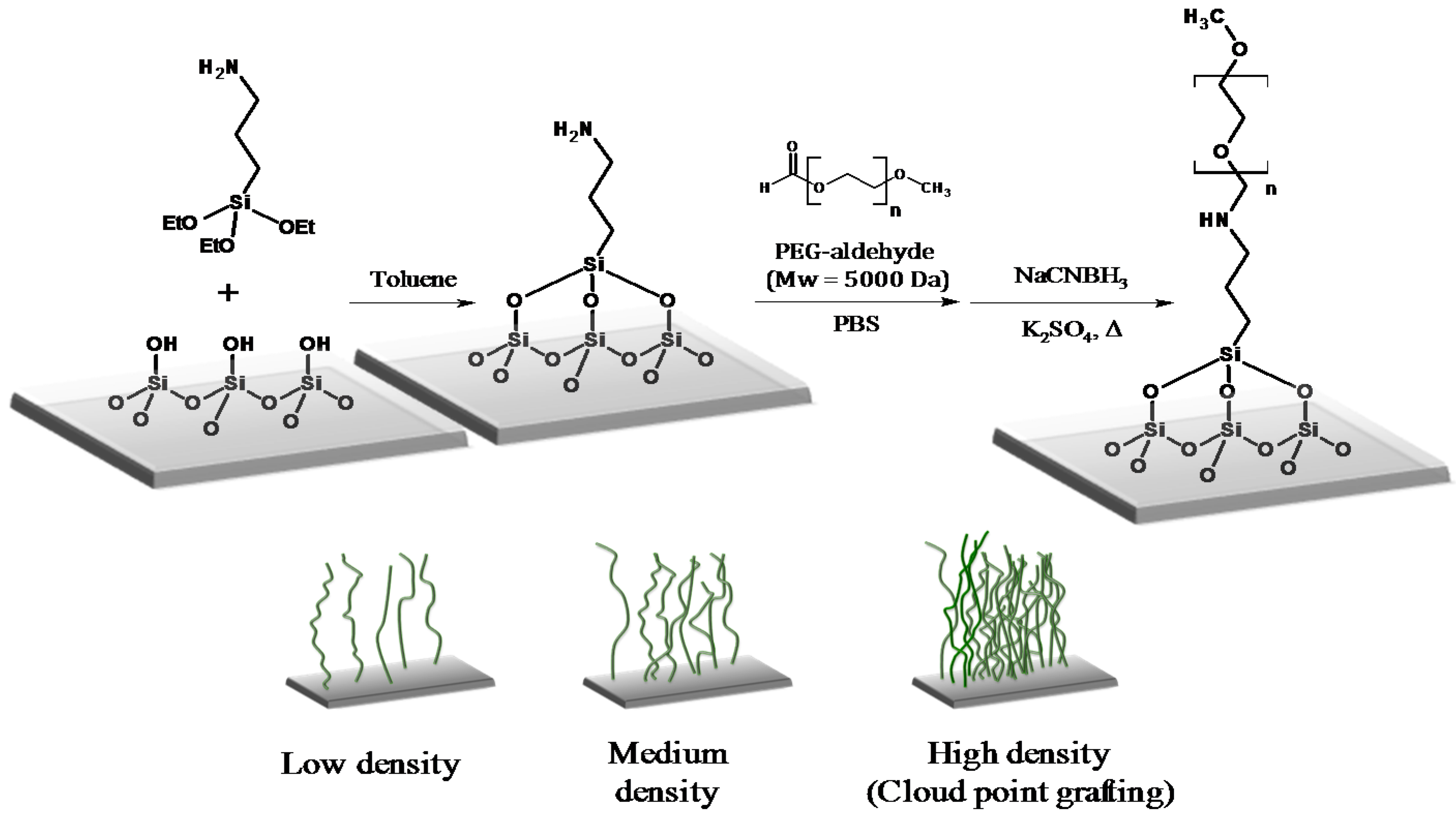

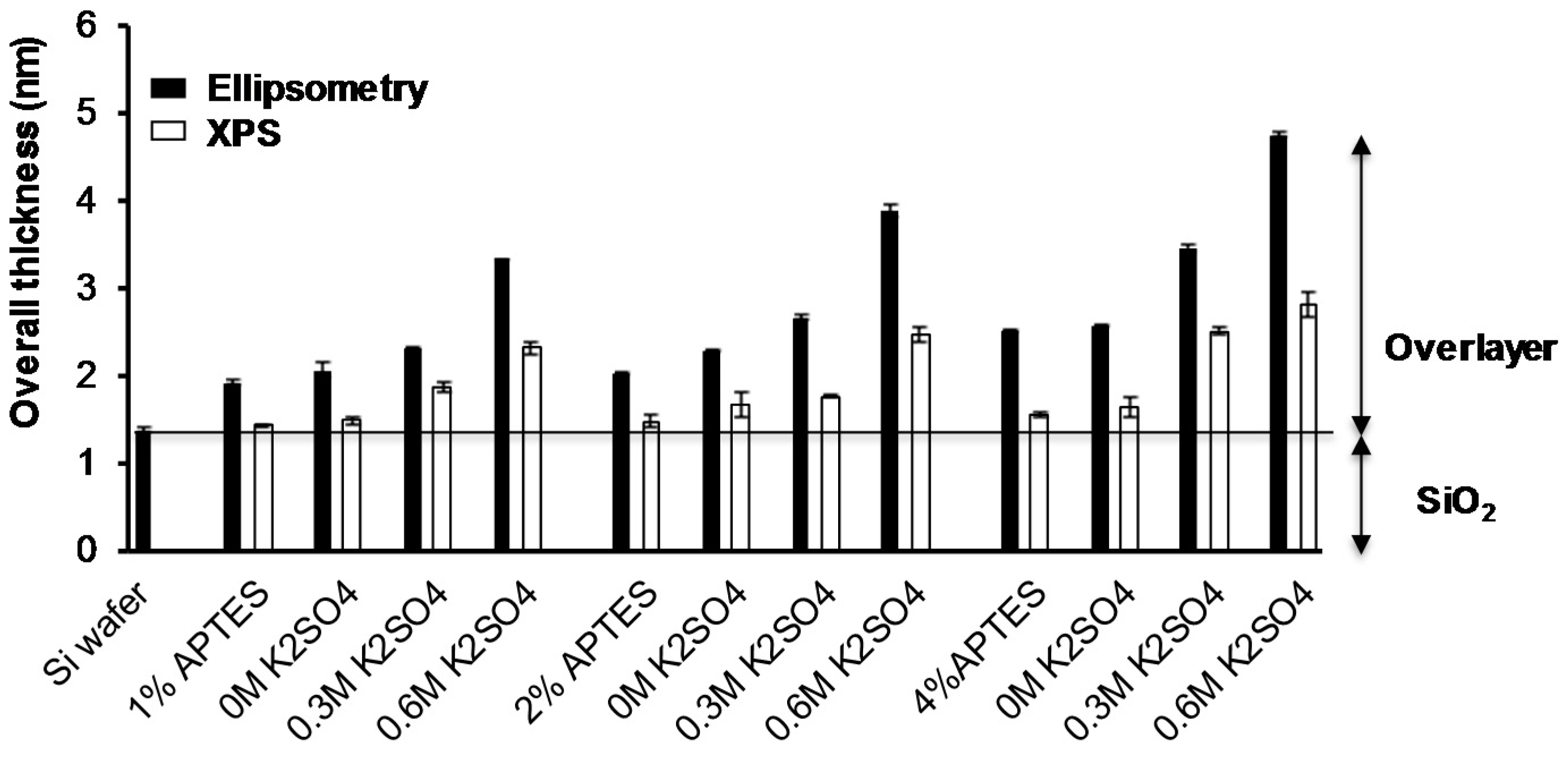
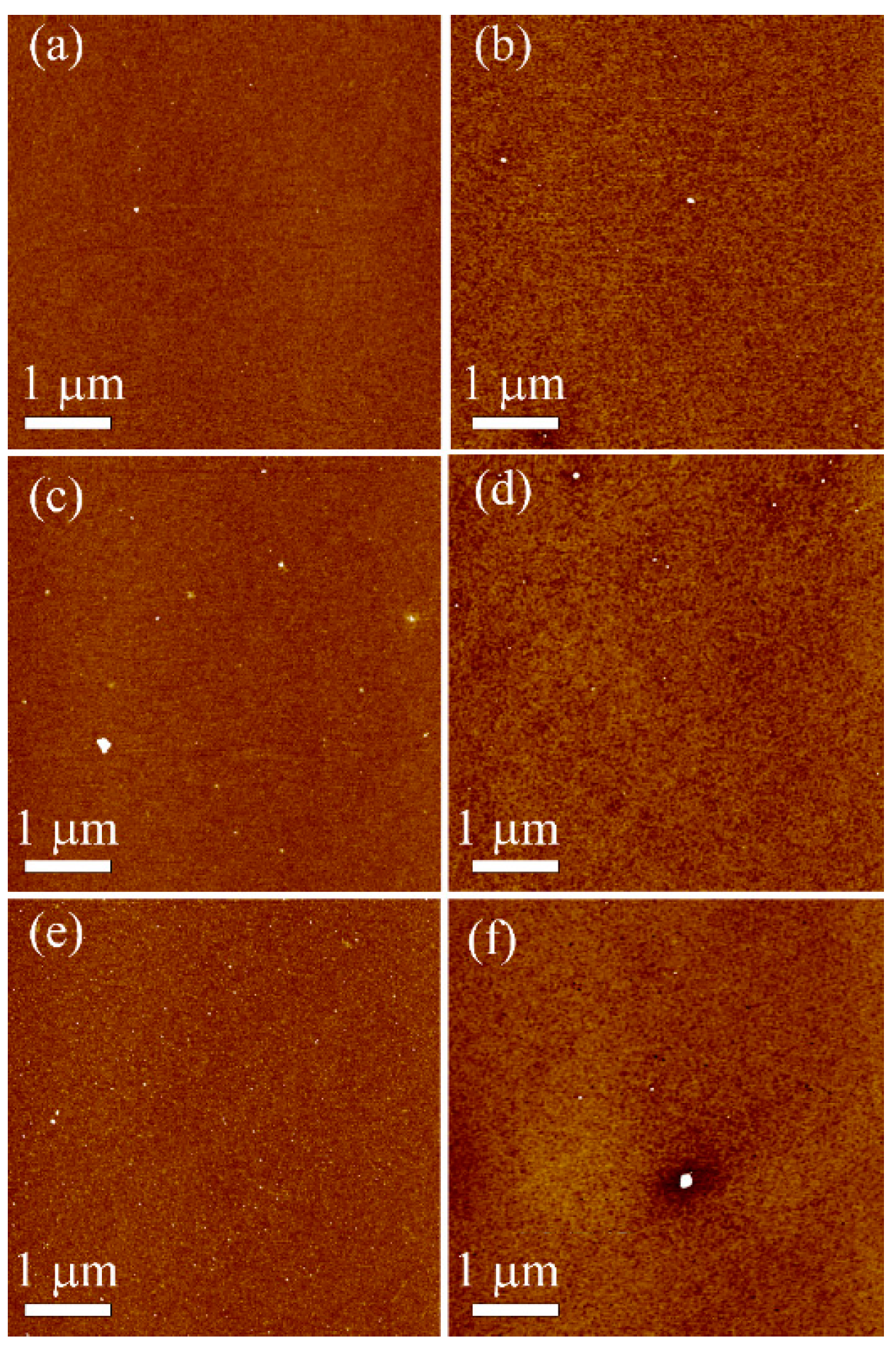

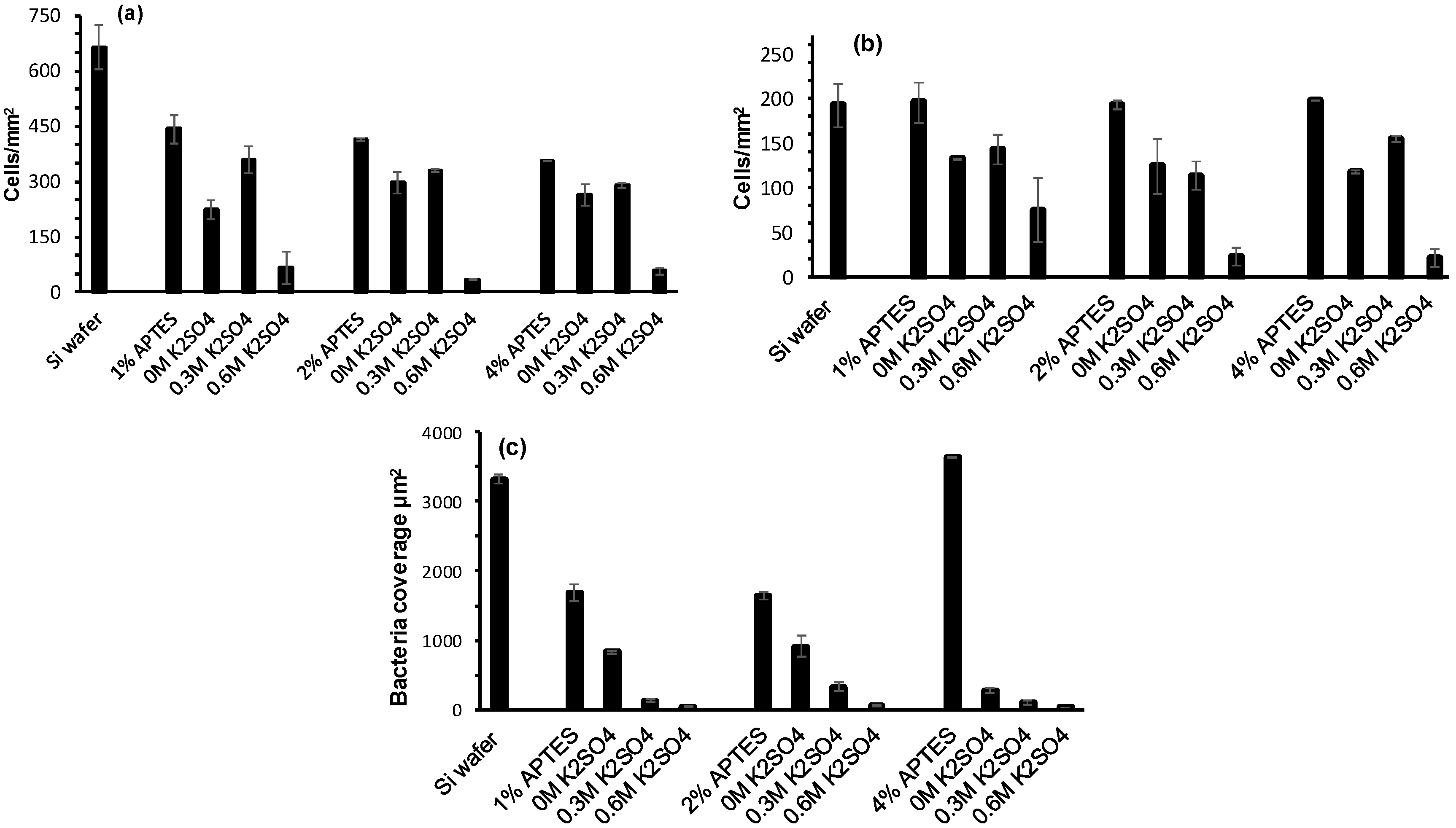
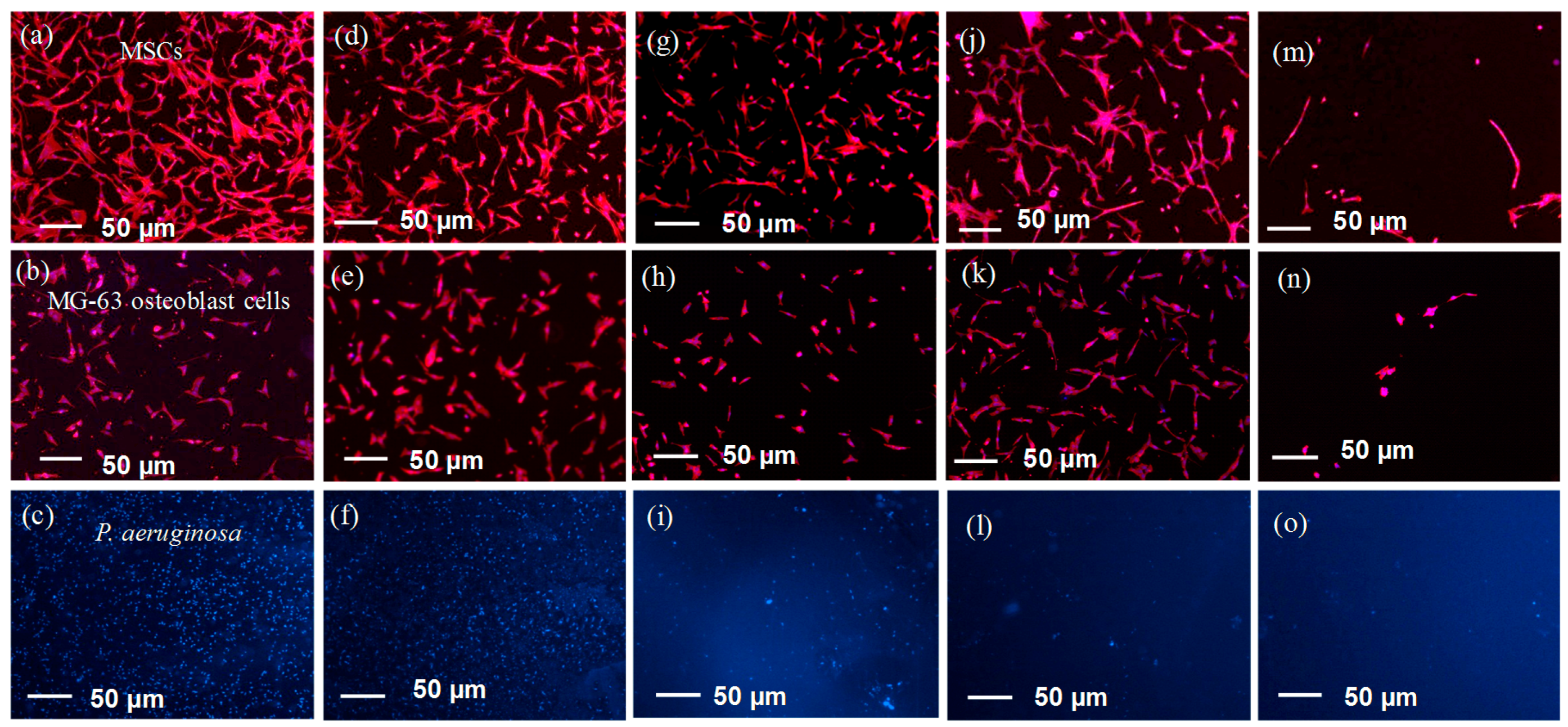

| Sampler | %C * | %O * | %N * | %Si * | %C ether/COH |
|---|---|---|---|---|---|
| Si wafer (control) | 8.6 ± 0.6 | 35.1 ± 0.6 | 0 | 56.3 ± 0.0 | 0 |
| 1% APTES (control) | 13.4 ± 0.2 | 33.0 ± 0.0 | 0.6 ± 0.0 | 52.9 ± 0.3 | 2.9 ± 0.3 |
| 1% APTES + PEG/0 M K2SO4 | 14.1 ± 0.0 | 33.3 ± 0.8 | 0.5 ± 0.0 | 52.1±0.8 | 7.9 ± 0.1 |
| 1% APTES + PEG/0.3 M K2SO4 | 21.0 ± 0.5 | 32.1 ± 0.2 | 0.3 ± 0.4 | 46.6 ± 0.8 | 14.7 ± 0.6 |
| 1% APTES + PEG/0.6 M K2SO4 | 34.0 ± 0.1 | 32.1 ± 0.2 | ~0 | 34.0 ± 0.2 | 27.7 ± 1.2 |
| 2% APTES (control) | 13.7 ± 0.4 | 31.8 ± 0.5 | 1.2 ± 0.3 | 53.3 ± 0.5 | 2.9 ± 0.1 |
| 2% APTES + PEG/0 M K2SO4 | 16.2 ± 1.1 | 33.2 ± 0.3 | 0.9 ± 0.1 | 49.7 ± 0.8 | 10.0 ± 0.6 |
| 2% APTES + PEG/0.3 M K2SO4 | 25.3 ± 1.5 | 32.1 ± 0.0 | 0.7 ± 0.1 | 41.9 ± 1.4 | 19.8 ± 1.2 |
| 2% APTES + PEG/0.6 M K2SO4 | 36.8 ± 0.7 | 32.4 ± 0.2 | ~0 | 30.9 ± 0.5 | 30.3 ± 1.1 |
| 4% APTES (control) | 18.9 ± 0.2 | 31.3 ± 0.3 | 2.2 ± 0.1 | 47.8 ± 0.2 | 1.8 ± 0.2 |
| 4% APTES + PEG/0 M K2SO4 | 23.3 ± 0.8 | 32.0 ± 0.3 | 1.5 ± 0.1 | 43.3 ± 0.4 | 15.3 ± 0.8 |
| 4% APTES + PEG/0.3 M K2SO4 | 32.0 ± 0.2 | 31.9 ± 0.3 | 1.3 ± 0.0 | 34.9 ± 0.5 | 21.6 ± 0.6 |
| 4% APTES + PEG/0.6 M K2SO4 | 43.1 ± 0.7 | 31.8 ± 0.0 | 1.0 ± 0.1 | 24.1 ± 0.8 | 35.9 ± 2.2 |
| Sample | Water Contact Angle (θ) | Roughness (Rq) (nm) | Roughness (Ra) (nm) |
|---|---|---|---|
| Si wafer (control) | 26 ± 0.4 | 0.18 ± 0.02 | 0.13 ± 0.01 |
| 1% APTES (control) | 38.5 ± 2.2 | 0.19 ± 0.03 | 0.16 ± 0.05 |
| 1% APTES + PEG/0 M K2SO4 | 36.9 ± 1.5 | ||
| 1% APTES + PEG/0.3 M K2SO4 | 34.7 ± 1.6 | ||
| 1% APTES + PEG/0.6 M K2SO4 | 31.3 ± 1.3 | 0.30 ± 0.06 | 0.19 ± 0.01 |
| 2% APTES (control) | 43.4 ± 0.6 | 0.26 ± 0.06 | 0.14 ± 0.01 |
| 2% APTES + PEG/0 M K2SO4 | 38.1 ± 1.9 | ||
| 2% APTES + PEG/0.3 M K2SO4 | 31.4 ± 0.7 | ||
| 2% APTES + PEG/0.6 M K2SO4 | 29.4 ± 0.9 | 0.35 ± 0.22 | 0.18 ± 0.01 |
| 4% APTES (control) | 57 ± 3.1 | 0.26 ± 0.06 | 0.16 ± 0.01 |
| 4% APTES + PEG/0 M K2SO4 | 41.3 ± 2.5 | ||
| 4% APTES + PEG/0.3 M K2SO4 | 31.0 ± 0.6 | ||
| 4% APTES + PEG/0.6 M K2SO4 | 29.5 ± 0.7 | 0.69 ± 0.75 | 0.21 ± 0.03 |
| Sampler | %C * | %O * | %N * | %Si * | %N 1s Amide |
|---|---|---|---|---|---|
| Si wafer (control) | 39.8 ± 1.1 | 22.5 ± 0.05 | 8.8 ± 0.3 | 28.9 ± 1.4 | 0 |
| 1% APTES (control) | 32.2 ± 0.5 | 24.5 ± 0.3 | 6.8 ± 0.3 | 36.3 ± 0.5 | 7.1 ± 0.1 |
| 1% APTES + PEG/0 M K2SO4 | 31.8 ± 0 | 24.7 ± 0.1 | 6.9 ± 0.4 | 36.5 ± 0.2 | 7.0 ± 0.1 |
| 1% APTES + PEG/0.3 M K2SO4 | 31.9 ± 0.4 | 25.7 ± 0.3 | 5.8 ± 0 | 36.5 ±0.7 | 5.9 ± 0.1 |
| 1% APTES + PEG/0.6 M K2SO4 | 22.2 ± 1.1 | 30.3 ± 0.2 | 1.0 ± 0.1 | 46.5 ± 1 | 1.2 ± 0.1 |
| 2% APTES (control) | 35.2 ± 0 | 24.7 ± 0.2 | 7.3 ± 0.1 | 32.7 ± 0.1 | 7.6 ± 0.1 |
| 2% APTES + PEG/0 M K2SO4 | 33.8 ± 1.9 | 24.6± 0.5 | 7 ± 0.5 | 34.5 ± 1.9 | 7.2 ± 0.3 |
| 2% APTES + PEG/0.3 M K2SO4 | 24.2 ± 0.6 | 26.6 ± 0.2 | 4.1 ± 0.1 | 45.1 ± 0.3 | 4.1 ± 0.4 |
| 2% APTES + PEG/0.6 M K2SO4 | 19.4 ± 0.3 | 30.1 ± 0.2 | 0.7 ± 0.1 | 49.9 ± 0.2 | 1.1 ± 0.1 |
| 4% APTES (control) | 46.1 ± 0.5 | 23.1 ± 0.1 | 10.4 ±0.1 | 20.5 ± 0.5 | 9.7 ± 0.1 |
| 4% APTES + PEG/0 M K2SO4 | 39.1 ± 0.4 | 22.8 ± 0.7 | 8.0 ± 0.1 | 30.1 ± 0.2 | 7.9 ± 0.1 |
| 4% APTES + PEG/0.3 M K2SO4 | 23.6 ± 1.7 | 27.8 ± 0.3 | 3.1 ± 0.2 | 45.5 ± 1.5 | 3.3 ± 0.05 |
| 4% APTES + PEG/0.6 M K2SO4 | 23.0 ± 0.1 | 30.7 ± 0.1 | 1.2 ± 0.3 | 45.2 ± 0.1 | 0.7 ± 0.02 |
| Sample | Water Contact Angle (θ) | Ellipsometry (nm) |
|---|---|---|
| Si wafer (control) | 52.1 ± 4.5 | 3.6 ± 0.4 |
| 1% APTES (control) | 55.2 ± 2.3 | 3.6 ± 0.4 |
| 1% APTES + PEG/0 M K2SO4 | 45.3 ± 2.2 | 4.1 ± 0.3 |
| 1% APTES + PEG/0.3 M K2SO4 | 42.5 ± 1.6 | 3.8 ± 0.1 |
| 1% APTES + PEG/0.6 M K2SO4 | 36.4 ± 3.3 | 3.5 ± 0.04 |
| 2% APTES (control) | 50.2 ± 1.5 | 3.0 ± 0.7 |
| 2% APTES + PEG/0 M K2SO4 | 45.0 ± 2.3 | 3.8 ± 0.2 |
| 2% APTES + PEG/0.3 M K2SO4 | 35.0 ± 1.1 | 3.4 ± 0.1 |
| 2% APTES + PEG/0.6 M K2SO4 | 30.3 ± 3.3 | 3.9 ± 0.1 |
| 4% APTES (control) | 72.1 ± 1.6 | 4.1 ± 1.0 |
| 4% APTES + PEG/0 M K2SO4 | 60.3 ± 1.8 | 3.9 ± 0.5 |
| 4% APTES + PEG/0.3 M K2SO4 | 41.2 ± 2.4 | 4.0 ± 0.4 |
| 4% APTES + PEG/0.6 M K2SO4 | 32.1 ± 1.3 | 5.1 ± 0.1 |
© 2017 by the authors. Licensee MDPI, Basel, Switzerland. This article is an open access article distributed under the terms and conditions of the Creative Commons Attribution (CC BY) license (http://creativecommons.org/licenses/by/4.0/).
Share and Cite
Al-Ani, A.; Pingle, H.; P Reynolds, N.; Wang, P.-Y.; Kingshott, P. Tuning the Density of Poly(ethylene glycol) Chains to Control Mammalian Cell and Bacterial Attachment. Polymers 2017, 9, 343. https://doi.org/10.3390/polym9080343
Al-Ani A, Pingle H, P Reynolds N, Wang P-Y, Kingshott P. Tuning the Density of Poly(ethylene glycol) Chains to Control Mammalian Cell and Bacterial Attachment. Polymers. 2017; 9(8):343. https://doi.org/10.3390/polym9080343
Chicago/Turabian StyleAl-Ani, Ahmed, Hitesh Pingle, Nicholas P Reynolds, Peng-Yuan Wang, and Peter Kingshott. 2017. "Tuning the Density of Poly(ethylene glycol) Chains to Control Mammalian Cell and Bacterial Attachment" Polymers 9, no. 8: 343. https://doi.org/10.3390/polym9080343




